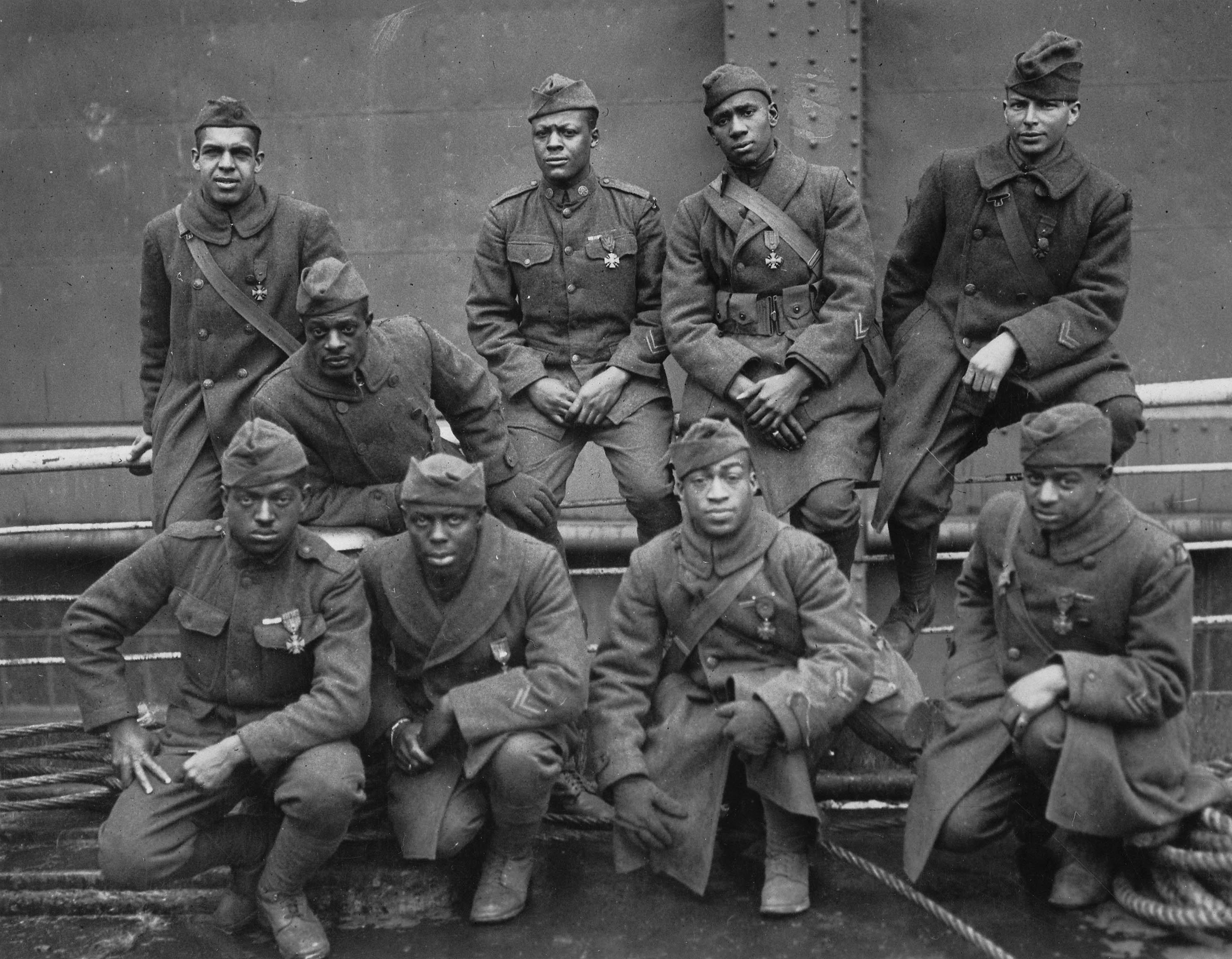American troops in the field during World War I

Topics on the Page
The Decision to Enter the War
Four Main Factors
- Submarine Warfare
- The Zimmerman Telegram
- Fall of the Russian Tsar
- US Loans to Britain
African American Troops
Cross-Link: Women in World War I
Technology During World War I
 Cross-Link
Cross-Link
 Cross-Links
Cross-Links
The Decision to Enter the War
Consider an explanation of the factors that led to the US to enter the War from Khan Academy.
Read a Digital History summary on the U.S. entering into the War
View a History channel video on why the U.S. entered the War.
- Many people believe it was the sinking of the British passenger ship the Lusitania that led President Wilson to seek a formal declaration of war against Germany, but his declaration came two years after the sinking of the Lusitania.
- President Woodrow Wilson didn't call for a war against Germany until April 2, 1917. US troops joined their allies on April 6, 1917.
- The US entered the War due to four main factors:
- the Germans' continuing unrestricted submarine warfare,
- the Zimmermann Telegram,
- the fall of the Russian Tsar, and
- the massive loans the US gave to Britain (U.S. loans to the Allies soared the 2.25 billion dollars).
 The United States Enters WWI: PBS
The United States Enters WWI: PBS
- Take a look at the discussion questions!
 Here's a short podcast to set the stage of the U.S.'s decision to enter WWI.
Here's a short podcast to set the stage of the U.S.'s decision to enter WWI.
Four Main Factors
Submarine Warfare
- Germany's continued unrestricted submarine warfare was the primary factor for the United States' entry into WWI
- In 1916, the Germans sunk a French ship called the Sussex, prompting President Woodrow Wilson to threaten to sever diplomatic relations with Germany
- On May 4, 1916, the German government agreed to the Sussex Pledge
- Agreed to refrain from attacking all passenger ships and allowing enemy merchant vessels to be abandoned before any attack
- By 1917, German navy officers convinced the military leaderships to break the Sussex Pledge
- Claimed the US had broke the agreement first by supplying support to the Allies
- German Chancellor Theobald von Bethmann-Hollweg believed this decision would draw the United States into the war resulting in German defeat
- The German government ignored his protest and resumed unrestricted warfare
- Believed they could end the war before the US troops officially joined the war
- Immediately following this decision, President Wilson severed diplomatic relations with Germany
- However, he did not officially declare war because he did not have ample proof that Germany was actually going to carry out attacks
- Multiple attacks and numerous deaths (including deaths of civilians) led Wilson to officially request a declaration of war from Congress
For more information WATCH the two videos and READ the article: Unrestricted U-Boat Warfare
 German Submarine WWI
German Submarine WWI
"Exploding in his hands" - a political cartoon about the Zimmerman Telegram, March 1917

The Zimmermann Telegram
- On January 19, 1917, British naval intelligence intercepted and decrypted the telegram sent by German Foreign Minister Arthur Zimmermann
- The telegram promised to help Mexico recover territory it had lost to the United States if Mexico supported Germany in the war
- The British debated whether or not to tell US officials about the telegram, in order to keep their ability to break German codes secret
- However, the British used the telegram and the resumed unrestricted submarine attacks to persuade the US to join the war
- President Wilson received the telegram on February 24th
- Wilson had been hesitant to declare war since the beginning of the war
- However, the continued submarine attacks and the implications of the Zimmermann Telegram had swayed public opinion into supporting the war
- Furthermore, the placement of US naval personnel on civilian ships was already an act of war according to international law
- Germany also had no interest in peacefully ending the war
 Click here to read the contents of the Zimmerman Telegram.
Click here to read the contents of the Zimmerman Telegram.
 Click here for a lesson plan on the Zimmerman Telegram based on the SOAPSTone method
Click here for a lesson plan on the Zimmerman Telegram based on the SOAPSTone method
Fall of the Russian Tsar
- Nikolai Romanov (1868-1918) and served as Tsar from 1894-1914. He graduated military school as a general.
- Without understanding government affairs, he was in over his head. Nicholas was a very conservative, absolute ruler, and believer in divine right while Russia was in great need of agricultural reform. Nicholas brutally suppressed any insurrection against him and had antisemitic ministers.
- There was a revolution in 1905 which had huge protests and strikes. Hundreds of people were shot during the revolution. Eventually, the revolution forced him to establish basic civil rights.
- At the outbreak of the first World War, Russia's military elite were on holiday, but Russia supported Serbia and had as strong alliance with France, so Russia went to War against the Kaiser. Nicholas took control of the army, which may have been his greatest mistake in his entire reign and was blamed for every defeat and failure. His wife controlled the government affairs, and ministers were dismissed, which destabilized the government more.
- The winter of 1917 was brutal and revolution was in the air. On March 12, 1917, soldiers put down their guns and joined the revolution. Nicholas became Nikolai once again and once the Bolsheviks took control, the family was killed and mutilated but the public was only informed about Nicholas. The other deaths remained secret until 1925.
- Many Russians did not support entering WWI because the economy was doing very poorly under the Provisional Government. Read here about the differences in opinion on Russia's involvement in the war between the civilians and the elites.
- As Russia left the war, the question was if the United States could get enough troops in to tilt the scale in favor of the allies. They brought in the men, the material, and the resources that the allies needed desperately. The French and the British were suffering because of the stalemate and a potential defeat. The US entry and helping to bring the end of the war, The US positioned itself as a world power.
 Click here for a New York Times Lesson plan on the general Russian Revolution.
Click here for a New York Times Lesson plan on the general Russian Revolution.

Click here for a video on the last Russian Tsar and his connection to World War I.
Click here for an intense National Geographic video on the cover up and deaths of the Romanov family.
 Click here for images of the Russian Revolution
Click here for images of the Russian Revolution
 --> If you look through the photos you will see images of Women Soldiers. Go here to learn about Maria Bochkareva and The Women Warriors of the Russian Revolution!!
--> If you look through the photos you will see images of Women Soldiers. Go here to learn about Maria Bochkareva and The Women Warriors of the Russian Revolution!!
US Loans to Britain
- The U.S. was conflicted as to loan any nation fighting in the war or not, while they were in a neutral position.
- In October 1915, President Wilson permitted loans to belligerents, a decision that greatly favored Britain and France. By 1917, American loans to the Allies had soared to $2.25 billion; loans to Germany stood at a paltry $27 million.
- By early 1917, the allied forces were on the brink of collapse. Ten divisions of the French army had begun to mutiny. In March 1917, the Bolsheviks, who had seized power in Russia in November, accepted Germany's peace terms and withdrew from the war. Then, German and Austrian forces routed the Italian armies.
- As a preliminary step, American ships relieved the British of responsibility for patrolling the Western Hemisphere, while another portion of the U.S. fleet steamed to the north Atlantic to combat German submarines. This led to U.S. entry into World War One
Click here for a lesson plan on the chronology of World War One which includes the reasoning for giving loans to other countries.
Click here for a primary source on the U.S. policy on war loans to belligerents.
Men of the 369th (15th N.Y.) who won the Croix de Guerre for gallantry in action (January 1919).

African American troops in WWI
 W.E.B. Du Bois "Close Ranks" (July 1918)
W.E.B. Du Bois "Close Ranks" (July 1918)
- Many African Americans did not want to fight alongside white Americans in WWI unless the army was desegregated.
- However, many prominent African Americans, such as Du Bois, called for African Americans to fight regardless.
- As Du Bois states German power represents the death of the fight for equality, freedom, and democracy for African Americans. Fight for democracy abroad in order to strengthen the claim back home (extremely similar to the Double V campaign in WWII)
 Documentary: Harlem Hellfighters
Documentary: Harlem Hellfighters
Who Were the Harlem Hellfighters?
We Return Fighting: African American Experience in World War I
Women in World War I
 The Hello Girls
The Hello Girls
America's First Women Soldiers were French/English bilingual translators who served on the front lines as telephone operators during World War I
IMAGES of the Hello Girls
.png) 100 Years On, The 'Hello Girls' are Recognized for World War I Heroics, NPR (November 9, 2018)
100 Years On, The 'Hello Girls' are Recognized for World War I Heroics, NPR (November 9, 2018)
Hello Girls Trailer
Marie Curie in World War I
- Did you know Marie Curie trained 150 women in radiology, anatomy, car repair, and photo processing during World War I?
- Curie established 200 radiological labs in battlefield hospitals. Due to that, one million Allied soldiers received x-rays during the war.
.png) Click here for a video on the hidden history of women involved in World War I.
Click here for a video on the hidden history of women involved in World War I.
.png) Click here for a lesson plan on women's roles in World War I.
Click here for a lesson plan on women's roles in World War I.
 LGBTQ+ Involvement in WWI
LGBTQ+ Involvement in WWI
- Many closeted homosexuals fought in WWI with the same sense of patriotism and pride that other soldiers exhibited
- However, following the war, they felt that their service for their country meant that the government owed them full citizenship.
- LGBTQ men and women served in the war, women mostly in the Red Cross or as medics, and men as soldiers and engineers. Here is an article with some of their stories.
- WWI is significant to gay history because U.S. military law did not expressly prohibit homosexuality or homosexual conduct until World War I.
.png) Here is a video from Rolling Stone about how the exclusion of gay people in the military created a stronger sense of LGBTQ identity.
Here is a video from Rolling Stone about how the exclusion of gay people in the military created a stronger sense of LGBTQ identity.
.png) Technology During World War I
Technology During World War I
British Tank, 1917

WWI: Technology and the Weapons of War
The Technology of World War I
Comments (0)
You don't have permission to comment on this page.